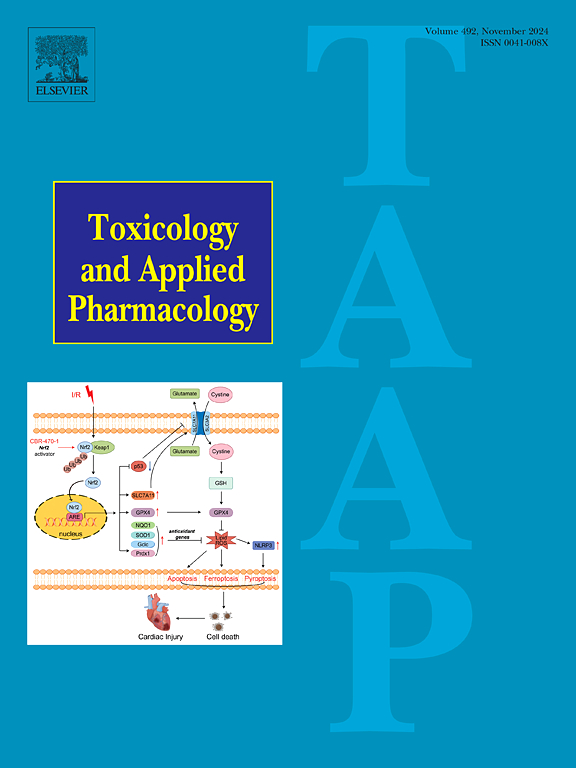氨基甲酸酯类农药对人羧酸酯酶抑制作用的评价。
IF 3.3
3区 医学
Q2 PHARMACOLOGY & PHARMACY
引用次数: 0
摘要
氨基甲酸酯类农药作为环境内分泌干扰物,广泛应用于农业生产和生活环境中,对脂质代谢具有破坏作用。本研究旨在研究CMs对关键水解酶羧酸酯酶1 (CES1)和羧酸酯酶2 (CES2)活性的抑制行为,从新的角度阐明其毒性机制。基于网络毒理学分析,CESs被确定为cms诱导的脂质代谢紊乱的潜在靶点。体外培养实验表明,大多数CMs对CES1和CES2的活性有较强的抑制作用,抑制率超过80% %。动力学研究和体内外推表明,CMs可能通过抑制体内CESs来破坏脂质代谢稳态。分子对接结果表明,氢键和酯键形成的疏水接触促成了CMs与CESs的相互作用。细胞荧光成像证实了CMs对HepG2细胞CESs的抑制作用。这些发现为理解cms通过抑制CESs介导的脂质代谢紊乱机制提供了新的实验依据。本文章由计算机程序翻译,如有差异,请以英文原文为准。

Evaluation of the inhibitory effects of carbamate pesticides on human carboxylesterases
Carbamate pesticides (CMs), which are widely applied in agricultural production and living environments, have been confirmed to exhibit disruptive effects on lipid metabolism as environmental endocrine disruptors. The present study aims to investigate the inhibition behavior of CMs on the activity of the critical hydrolytic enzymes, carboxylesterase 1 (CES1) and carboxylesterase 2 (CES2), to elucidate the toxicity mechanisms from a novel perspective. Based on network toxicology analysis, CESs were identified as potential targets for CMs-induced lipid metabolism disorders. In vitro incubation experiments demonstrated that most CMs strongly inhibited the activity of CES1 and CES2, with inhibition ratios exceeding 80 %. Kinetic studies and in vitro-in vivo extrapolation revealed that CMs might disrupt the metabolic homeostasis of lipids by inhibiting CESs in vivo. Molecular docking results revealed that hydrogen bonds and hydrophobic contacts formed by ester bonds contributed to the interaction of CMs towards CESs. Cellular fluorescence imaging confirmed the inhibition of CMs on CESs in HepG2 cells. These findings provide new experimental evidence for understanding the mechanism of CMs-mediated lipid metabolism disorders through inhibition on CESs.
求助全文
通过发布文献求助,成功后即可免费获取论文全文。
去求助
来源期刊
CiteScore
6.80
自引率
2.60%
发文量
309
审稿时长
32 days
期刊介绍:
Toxicology and Applied Pharmacology publishes original scientific research of relevance to animals or humans pertaining to the action of chemicals, drugs, or chemically-defined natural products.
Regular articles address mechanistic approaches to physiological, pharmacologic, biochemical, cellular, or molecular understanding of toxicologic/pathologic lesions and to methods used to describe these responses. Safety Science articles address outstanding state-of-the-art preclinical and human translational characterization of drug and chemical safety employing cutting-edge science. Highly significant Regulatory Safety Science articles will also be considered in this category. Papers concerned with alternatives to the use of experimental animals are encouraged.
Short articles report on high impact studies of broad interest to readers of TAAP that would benefit from rapid publication. These articles should contain no more than a combined total of four figures and tables. Authors should include in their cover letter the justification for consideration of their manuscript as a short article.

 求助内容:
求助内容: 应助结果提醒方式:
应助结果提醒方式:


